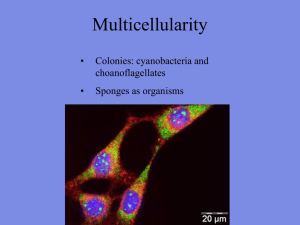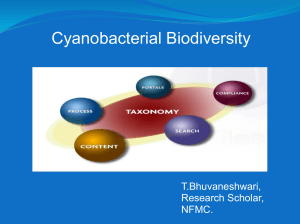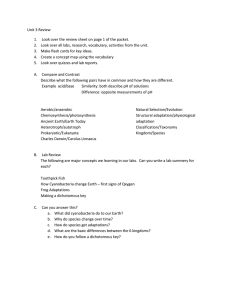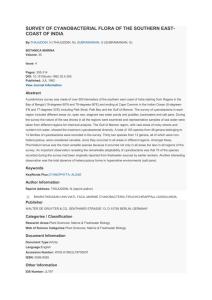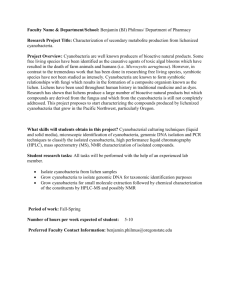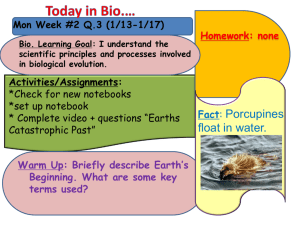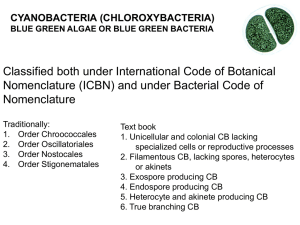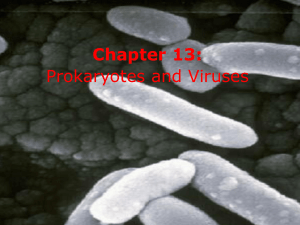Photosynthetic Prokaryotes Chapter 13 • Kingdom- Bacteria – Phylum- Cyanobacteria
advertisement
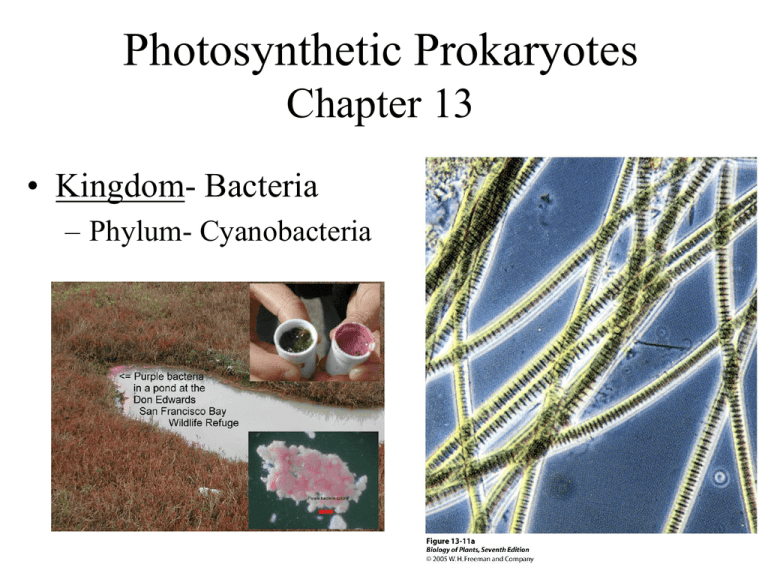
Photosynthetic Prokaryotes Chapter 13 • Kingdom- Bacteria – Phylum- Cyanobacteria Cyanobacteria- Gram Negative Bacteria • Gram positive- peptidoglycan layer; stains with crystal violet. • Gram negative- peptidoglycan layer sandwiched by lipopolysaccharide and protein layers; does not stain with crystal violet. Cyanobacteria • Characteristics – – – – – – – – – Chlorophyll A Phycobilisomes Thylakoids occur singly 70s ribosomes DNA microfibrils central Polyhedral bodies Gas vesicles Habitat- ubiquitous. Examples- Anabaena, Nostoc, Oscillatoria, Lyngbya, Synechococcus, Synechocystis. Habits • Unicells – Singly- Synechocystis – Colonies of unicells- Aphanothece • Rows of cells – – – – – – Unbranched filaments w/out sheath (trichome)- Oscillatoria Many trichomes in 1 large sheath- Microcoleus Unbranched filaments with sheath- Lyngbya Uniseriate branched filaments- Mastigocladus Multiseriate branched filaments- Stigonema Pseudo-branched filaments- Scytonema Asexual Reproduction • Endospores- internal division of the protoplast results in a mass of spores. • Fragmentation- filament breaks into 2 parts, each of which forms a new thallus. • Hormogonia- short sections of a trichome detach and form a new thallus. • Akinetes- resting spores; cells that are resistant to unfavorable conditions. • Binary Fission- division of a single-celled individual into two new single-celled individuals. Heterocyst • Heterocyst- a thick-walled large cell that fixes atmospheric nitrogen (diazotroph). – Photosynthetically inactive. – Their formation is inversely related to nitrogen concentration. – Microplasmodesmata- cytoplasmic connections that transfer metabolites and ammonium. Movement in the Cyanobacteria • Gliding- active movement of an organism in contact with a solid substrate. – Mechanism- mucilaginous layer of microfibrils generates waves. • Swimming- active movement of an organism without contact with a substrate. – Mechanism- unknown. • Why? – Positively phototactic- dim light. – Positively chemotactic- nutrients. Symbiotic Associations • Lichens- cyanobacteria occur in about 8% of the species. • Azolla- the water fern; contains Anabaena in the dorsal lobe of its leaf. • Colonial ascidian- sea squirt. • Amoeba, protozoa, diatoms, green algae, mosses, liverworts, water molds, and vascular plants. Prochlorophytes • Characteristics – – – – – Chlorophylls A & B No phycobilisomes Thylakoids in stacks of 2 DNA microfibrils peripheral Habitat • 1) Obligate symbionts, live within sea squirts; 2) Planktonic filaments in freshwater lakes. – Example- Prochloron Stromatolites • Stromatolite- rock-like deposition of carbonates and trapped sediments; formed by cyanobacteria and diatoms. • Age- 3.5 BYA. • Growth-deposition-growthdeposition. • S-shaped in growth= 1 year. • Florida, Bahamas, Australia. Cyanobacteria Produce Cyanotoxins • Neurotoxins- alkaloids that target the nervous system. – Anatoxin and saxitoxin. – Symptoms- staggering, muscle twitching, gasping, and convulsions. – Anabaena, Aphanizomenon, Oscillatoria. • Hepatotoxins- large compounds that target the liver. – Microcystins and nodularins. – Symptoms- weakness, vomiting, diarrhea. – Anabaena, Microcystis, Oscillatoria, Nodularia, Nostoc.

